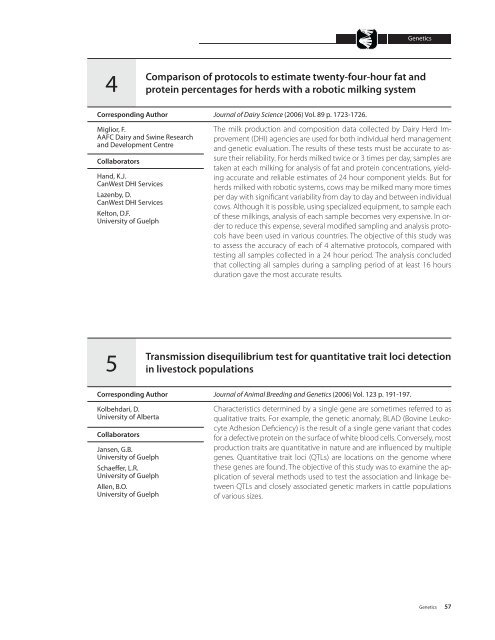A52-75-2007E.pdf - AgroMedia International Inc
A52-75-2007E.pdf - AgroMedia International Inc
A52-75-2007E.pdf - AgroMedia International Inc
You also want an ePaper? Increase the reach of your titles
YUMPU automatically turns print PDFs into web optimized ePapers that Google loves.
Genetics4Comparison of protocols to estimate twenty-four-hour fat andprotein percentages for herds with a robotic milking systemCorresponding AuthorMiglior, F.AAFC Dairy and Swine Researchand Development CentreCollaboratorsHand, K.J.CanWest DHI ServicesLazenby, D.CanWest DHI ServicesKelton, D.F.University of GuelphJournal of Dairy Science (2006) Vol. 89 p. 1723-1726.The milk production and composition data collected by Dairy Herd Improvement(DHI) agencies are used for both individual herd managementand genetic evaluation. The results of these tests must be accurate to assuretheir reliability. For herds milked twice or 3 times per day, samples aretaken at each milking for analysis of fat and protein concentrations, yieldingaccurate and reliable estimates of 24 hour component yields. But forherds milked with robotic systems, cows may be milked many more timesper day with significant variability from day to day and between individualcows. Although it is possible, using specialized equipment, to sample eachof these milkings, analysis of each sample becomes very expensive. In orderto reduce this expense, several modified sampling and analysis protocolshave been used in various countries. The objective of this study wasto assess the accuracy of each of 4 alternative protocols, compared withtesting all samples collected in a 24 hour period. The analysis concludedthat collecting all samples during a sampling period of at least 16 hoursduration gave the most accurate results.5Transmission disequilibrium test for quantitative trait loci detectionin livestock populationsCorresponding AuthorKolbehdari, D.University of AlbertaCollaboratorsJansen, G.B.University of GuelphSchaeffer, L.R.University of GuelphAllen, B.O.University of GuelphJournal of Animal Breeding and Genetics (2006) Vol. 123 p. 191-197.Characteristics determined by a single gene are sometimes referred to asqualitative traits. For example, the genetic anomaly, BLAD (Bovine LeukocyteAdhesion Deficiency) is the result of a single gene variant that codesfor a defective protein on the surface of white blood cells. Conversely, mostproduction traits are quantitative in nature and are influenced by multiplegenes. Quantitative trait loci (QTLs) are locations on the genome wherethese genes are found. The objective of this study was to examine the applicationof several methods used to test the association and linkage betweenQTLs and closely associated genetic markers in cattle populationsof various sizes.Genetics 57





